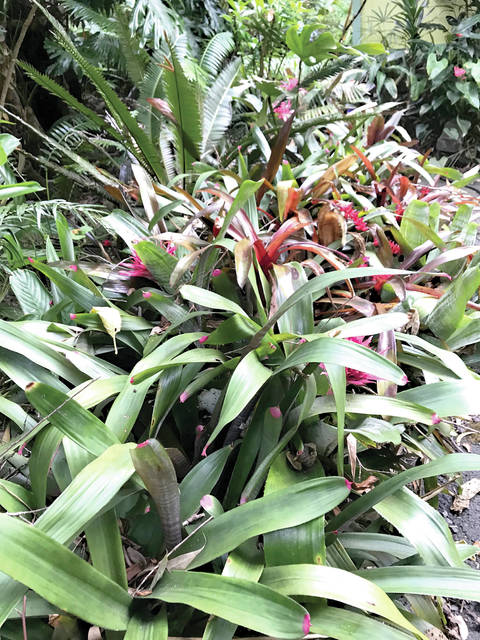Tropical Gardening: Virulent fungus disease threatens ‘ohi‘a forests

Photo courtesy of VOLTAIRE MOISE
Bromeliads, philodendrons, Monstera, ferns and mondo are among the many plants that thrive under heavy shade of trees such as the banyan and monkeypod, where grasses have a difficult time growing.
Now, while the sun is still south of the equator, it is a good idea to consider doing some selective tree pruning.
Now, while the sun is still south of the equator, it is a good idea to consider doing some selective tree pruning.
When the sun is strong in summer, pruning can expose remaining branches and even trunks to sunburn. Sanitation also is important. Every time we prune our trees, we take a chance of carrying disease from one to another, so cleaning equipment is vital.
ADVERTISING
The fungus diseases causing bud rot of palms are examples. Citrus trees are subject to viruses spread by unsanitary pruning practices as well.
But on Hawaii Island, by far the most devastating disease spread by improper pruning is rapid ‘ohi‘a death, or ROD. This disease can be spread from one area to another by transporting infected ‘ohi‘a logs and green waste. Apparently, it also can be spread by mud on shoes or vehicles from infested areas, so sanitation is critical.
Even though we have been aware of ROD for several years, many folks did not become aware of the disease until recently. Thousands of acres in East Hawaii have been affected and now we are beginning to see what appears to be ROD in West Hawaii as well.
If you have healthy ‘ohi‘a on your property, then protect them by not infecting them with careless activities. If you have trees that suddenly died with no apparent cause, sanitation is key to avoid spreading disease to healthy trees.
Landscape gardeners and homeowners need to be vigilant. If you think you have ROD on your properties, contact the University of Hawaii Master Gardener hotline for further information at 322-4892 in Kona or 981-5199 in Hilo. You also can call J.B. Friday at 969-8254 if you have forested land.
At this time of year folks need to think about the potential for storms blasting in from the northwest. Because of climate change we are getting those in winter and tropical blasts from May to November.
Before the storm flag is hoisted, inspect your trees for dead branches that seem to be ready to fall. Also, look for dead branches that are firm but brittle. A gust of hurricane-force wind can snap an arm-size branch from a tree and send it at missile speed through a picture window.
A low hanging branch over a roof can wreak havoc. Powerful winds can turn the limb into a tool of destruction. This tool can remove shingles as easily as a fish can remove scales.
Removing dead and out of place limbs is a good idea even if there is no storm.
Fan-like fungus growing on the side of a tree trunk indicates rotten spots that need attention. A hole made by poor pruning, damage from earlier storms or the gouge of an auto bumper can start rotten spots. The auto-made wound can easily be filled with a watertight material as it is not more than kneeling height. But other rotting areas will require experience at climbing to dizzy heights on a trembling ladder.
Often it is cheaper in the long run to call a professional to handle the treetop jobs.
Some older trees with Y-shaped crotches are prone to cleave apart. Check the trees in this category. If necessary, place temporary props in the appropriate places or make the tree one unit again with steel rods and turnbuckles.
Remove decayed trees that are too weak to hold up under the strain of a storm. This action will save you grief later.
Palm fronds are wicked to deal with if propelled by an 80 mph wind. So, clean away all loose palm leaves at the first hint of a storm. Be careful not to overprune the palms. Overpruning will weaken and even kill them.
As soon as the storm passes it is a good idea to inspect the trees and other plants around the house. Usually, all the plants will show signs of wind damage. But with a little trimming, propping, resettling of root systems, fertilizing and watering, nearly all plants that were shaken loose from the ground can be salvaged.
Many tropical trees grow rampant with extensive root systems. That is why we prune to keep them from getting out of hand, but prune the correct way. After spring storms and hurricane season, you might want to consider some root pruning.
Here is a scheme to keep lawns and flowerbeds healthy, too.
The trouble with roots of many big trees, banyans (ficus species) and monkeypods especially, is that they are too greedy. Their roots will fill a flowerbed or a new lawn in just a few years after the trees were planted. When this happens, you can be sure they are not doing moisture-loving plants any good.
It is very likely the tree roots are competing so fiercely for soil’s available water and nutrients that grass will suffer. Planting shade-tolerant, drought resistant plants under the canopy is an alternative to grass.
Whether you are pruning branches or severing hungry roots, it is always a good idea to clean your equipment. Bleach or alcohol will do the job, but the former is less expensive.
Just keep in mind that an injury to a tree can be just as life threatening as an infected wound on a person. The best solution is preventing disease through sanitation.


